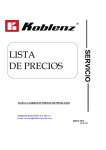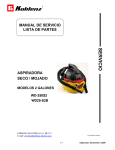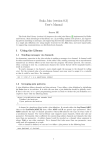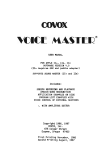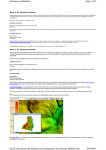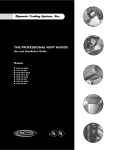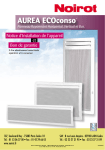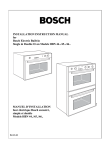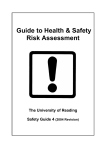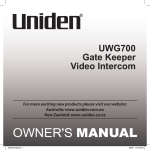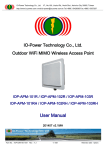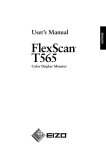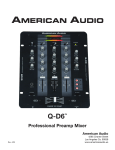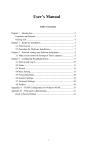Download MDB3113 - The Inauen Group
Transcript
MDB3113 XtraVac • MDB3113 Metal Detector Operating Instructions A Division of the Inauen Group ∙ Kansas City, MO Tel. 800-728-2999 ∙ Fax 816-472-1999 [email protected] Foreword Introduction Thank you very much for your purchasingWKH0'% metal detectorIURP;WUD9DF. This product is a new type of metal detector developed by our company on the basis of advanced technology andVLPSOHRSHUDWLRQ. This product has many advantages such as high sensitivity, powerful anti-interference capability, and stable performance etc. ThisUser Manual contains information necessary for use of the metal detector. In order to use the metal detector correctly, pleDVe read this manual carefully and understand all of its content before using the product. Please keep thisUser Manual in a safe place for further reference. After opening the package, carefully check the parts according to the accessory list (refer to the annexes). If any damage or missing parts, please contact;WUD9DF as soon as possible. ●Do not reprint all or part of this manual without permission. ●This manual may be modified without advance notice, please understand this. ●I) you do not understandWKLVPDQXDO or ILQGan error or omission in this book, please contact us. ●Please consult yourVDOHVUHS for detailed product features and performances before ordering the product, to see if they suit for your requirements. For more information, please visit;WUD9DFFRP, or consult your dealer, agent or after sales service department of our company. We will provide you withFRPSOHWH solutions for metal detecting. I Safety precautions In order to prevent users or other persons from injury, please comply with the following precautions. This equipment can be used only by properly trained and authorized personnel; any impermissible operation may cause damage to the equipment or injury to the personnel. Operation is prohibited Operation is a must Do not use this equipment in any purpose A hoisting device must be used if the weight other than detecting metal . of the goods beyond the manual handling Do not use this equipment in any place with capacity. explosive hazardV The power box must be closed when the Do not use this equipment at any place where equipment is working normally. temperature and humidity are out of Must ground the earth terminal effectively. permissible range. Must turn off the external power supply if the Do not use it if any electric cable is equipment won;t be used for a long time. damaged. Please strictly follow the operation and Do not detach or refit the electric circuit maintenance requirements in the user without authorization. manual. 8QWUDLQHGRSHUDWRUVDUHnot allowed to use Installation, connection and inspection of this this machine. equipment can only be done by professional technicians. II Table of Contents Foreword................................................................................................................................................... I Introduction....................................................................................................................................... I Safety precautions............................................................................................................................ II Table of Contents....................................................................................................................................III Product Description.................................................................................................................................. 1 Operational principle........................................................................................................................ 1 Metal identification...................................................................................................................1 Sensitivity difference................................................................................................................ 1 Specification of Detecting Tunnel.................................................................................................... 2 External appearance and size of the whole machine........................................................................ 2 Product features................................................................................................................................ 4 Application scope..................................................................................................................... 4 Features and performances....................................................................................................... 4 Equipment Installation..............................................................................................................................5 Installation........................................................................................................................................ 5 Installing the alarm device........................................................................................................5 Using it in production lines...................................................................................................... 6 Mounting/dismounting the detecting head............................................................................... 6 Check................................................................................................................................................ 7 Initial Start........................................................................................................................................ 7 Operation Instruction................................................................................................................................ 8 Human-Computer Interface.............................................................................................................. 8 Operating panel.........................................................................................................................8 Menu list................................................................................................................................... 9 Enter the menu..........................................................................................................................9 Adjustment......................................................................................................................................11 Sampling................................................................................................................................. 11 Parameter settings...................................................................................................................13 Statistic function..................................................................................................................... 15 System settings....................................................................................................................... 15 Conveyor belt speed............................................................................................................... 17 Sequence chart of the alarm time delay..................................................................................17 Cleaning and maintenance..............................................................................................................18 Cleaning the conveyor belt..................................................................................................... 18 Circuit check...........................................................................................................................19 Check the fasteners................................................................................................................. 19 Troubleshooting...................................................................................................................................... 20 Alarm signal in error.......................................................................................................................20 Failure to Start Up.......................................................................................................................... 20 Error Trigger................................................................................................................................... 21 Technical Parameters.............................................................................................................................. 22 III Technical Indexes........................................................................................................................... 22 Plan................................................................................................................................................. 23 Power panel part..................................................................................................................... 23 Control panel part................................................................................................................... 24 Wiring layout.................................................................................................................................. 25 Basic wiring............................................................................................................................ 25 Circuit board I/O connection.................................................................................................. 25 Relay....................................................................................................................................... 26 Appendixes............................................................................................................................................. 27 After-sale........................................................................................................................................ 27 Accessory list..................................................................................................................................27 IV Operation Instruction AC-RCB METAL DETECTOR Product Description Operational principle Metal identification The metal detector will generate an electromagnetic field in the detection area. If there is QRmetal substance in the detection area, its output is in an equilibrium state; if there is any metal substance in the detection area, the electromagnetic field will be disturbed and the equilibrium state is broken, the detecting sensor will generate a metal identification trigger signal, which will be processed by a dedicated circuit and then an alarm signal and a removing device control signal wilOWXUQRQ. Sensitivity difference ●Channel port size: The largeU the detecting coil, the weaker the magnetic field strength in the detection area, and so the disturbDQFH caused by tiny metal substances will be smaller; the larger the channel port, the lower the sensitivity. In order to ensure precise detection, a metal detecting head of proper size must be used to suit the product to be detected. Generally, the detecting range should be control to a minimum value possible, for detected products of high sensitivity to high frequency, the size of the channel port of the detector should suit for the size of the detection area. ●Different positions of the metal substances in the detection area: Generally, the magnetic field at the geometric center of the detection area is the weakest, so the weaker the sensitivity, the nearer to the center. ●Product effect: If a product contains moisture, large amount of salt and metal ions, it will be electro conductive and cause change of the magnetic field in the detection area, and this will interfere detection of metal substances. Generally phase detection technology is used to solve product effect problem so as to prevent error trigger. The detection sensitivity will be lowered if phase of the detected metal substance is similar to the phase of the product. 1 ;WUD9DF0'%0HWDO'HWHFWRU Operation Instruction Specifications R Model 0'%-A00,250,300,350 E 100,125 …175 F 105 L W R+255 290 H E+210 E+210 340/390 E+310 (Unit: mm) 0'%%350,400,...,800 100,125….400 130 R+315 External appearance and size of the whole machine 0'%%Standard (350×175) 2 2SHUDWLRQDO0DQXDO;WUD9DF0'%0HWDO'HWHFWRU Product features Application scope The product is mainly suitable for food Industry; it can be used to detect all kinds of metals such as broken needles, steel wires, lead, copper, aluminum, tin, stainless steel etc mixed in materials or products. Features and performances 1. Beautiful appearance, simple operation, and stable performance. 2. Fast detection speed, nonconforming information can be saved. 3. High sensitivity, detection precision is leading the industry. 4. Sound and light alarm signals are used, automatic removing metals or stop, convenient and reliable. 5. Can be connected to and used together with combined weighing scale and packing machine to carry out automatic detection in the production line. 6. The whole machine is made of stainless steel, corrosion proof, easy to clean, and maintenance free. 4 2SHUDWLRQDO0DQXDO;WUD9DF0'%0HWDO'HWHFWRU Equipment Installation Installation Installing the removing device (optional) When optional removing device is installed, Please note the air inlet and air outlet directions. The removing device should be firmly fixed on the machine frame, avoid large vibration that may cause error trigger of the detector. To get removing device work normally, pls keep the external input air pressure: 0.5Mpa—1.0Mpa. try and set the proper air pressure. Installing the material collecting box (optional) The material collecting box is made ofSODVWLF. Please install it carefully. Installing the alarm device The indicating light may not be installed in the normal position when delivered, for transport convenience. You can install the alarm in the reserved place, and adjust to proper height. Do not distort or hit the alarm during installation. 5 2SHUDWLRQDO0DQXDO;WUD9DF0'%0HWDO'HWHFWRU Using it in production lines The detector has an external signal output port, and can be connected to a production line to carry out automatic detection. This port has two sets of circuits, A and B. AB is passive switching value output, the port volume is 1A, 250VAC, 30VDC. ●A1A2 is pulse output: Pulse state means that when the alarm is triggered, this circuit will keep “ON” state for a period of time and then return to “OFF” state. It’s for controlling indicating light and rejecting device. The pulse width can be changed by adjusting the “signal width” parameter. This function is used in “Out mode :0”. Refer to chapter Operating instruction →Adjustment ●B1B2 is latched output mode: Latched state means that after the alarm is triggered, this circuit will keep “ON” state until the alarm is reset, then return to “OFF” state. This function is used for “Out mode:1”. This output mode is generally used when the product is used in a production line. It can be used to control the operation of combined weighing scales and packing machines etc if it is connected with the signal control circuits of these machines in series. Mounting/dismounting the conveyor belt Step 1: Take out the two plum hand-wheels (left and right) as indicated by mark 1 in the diagram; as indicated by mark 2, turn up the driven roller part, loosen the fixing screw of the bearing plate. Step 2: Remove the belt cover and take out the belt, carefully take out the main roller, and take out the bearing plate at the end part of the conveyor belt. Step 3: Take out the driven roller part, take out the bearing plate at the front part of the conveyor belt and then take out the conveyor belt. Install the conveyor belt in reverse order. The conveyor belt is not allowed to contact with the detecting head mechanically, it should be 10 mm away from the bottom of the detection area. Mounting/dismounting the detecting head 6 OSHUDWLRQDO0DQXDO;WUD9DF0'%0HWDO'HWHFWRU Detach the operating panel, take out the cable from the detecting head, and take out the bearing plate using the method of mounting/dismounting the conveyor belt, and then loosen the fixing nut on the detecting head, lift the detecting head to separate it from the machine frame. Please take care the length of the connecting cable when moving the detecting head. Install it in reverse order. When installing the detecting head, do not forget to put on the rubber pad, adjust the detecting head to a level position, the distance between the bottom of the detection area and the conveyor belt should be adjusted to ≥10mm, then tighten the locknut. The detecting head must be fixed to the machine frame through the threaded rod! And a rubber pad must be between the detecting head and the machine frame. During assembly, do not damage the rubber bushLQJ; do not let the threaded rod and nut directly contact the machine frame. 7 2SHUDWLRQDO0DQXDO;WUD9DF0'%0HWDO'HWHFWRU Check In order to let the detector work normally, after installation, check the following items before connecting it to power. ●The detector must be connected to a stable power supply voltage, the input power supply should be equipped with a 5A air switch, or an over current protective device of the same capacity. ●The detecting head should be firmly fixed to the machine frame, and the detecting head must be insulated from the machine frame, there should be no metal connection between them. ●,f external input air pressure LVneedHG, it should be kept at 0.5Mpa to 1.0Mpa. ●Keep away from large power equipment. ●Keep away from strong magnetic fieldV. ●Metal free zone is within 1.5 times of height of detecting head, before or behind opening tunnel. Within this distance, there shouldn’t be any metallic subject moving or rotating. ●Don’t touch or hit on the detecting head when machine’s running. Initial Start After the procedures described in previous section are completed and the metal detector is checked, you can start your equipment. Connect the detector to the power supply, turn the change-over switch to “ON” position, press the start button (START), the system starts, and carries out self-check for about 3 seconds, then enters stand-by mode after self-check is completed, conveyor belt starts revolving , the main menu is shown on the screen. You can turn the change-over switch to “OFF” position to stop the operation of the equipment. If the equipment is not used for a long time, please pull out the power supply plug. For operation of the detector, please read the following chapter – Operation Instruction. The equipment can only be operated by trained and authorized personnel. The places bearing warning signs are dangerous areas of the equipment; do not open them without authorization. 8 2SHUDWLRQDO0DQXDO;WUD9DF0'%0HWDO'HWHFWRU Operation Instruction Human-Computer Interface The metal detector is operated through the operating panel of the control unit, all information needed for operation are displayed on the screen. Operating panel If you are in the main menu, you can enter the desired submenu by pressing the correspondingEXWWRQ 9 2SHUDWLRQDO0DQXDO;WUD9DF0'%0HWDO'HWHFWRU Menu list 1.RUN 4.STATISTICS INPUT RECORD CLEAR RECORD 5.SAMPLE(password) PROD.SAMPLE VIBR.SAMPLE 6.SYSTEM SET(password) DATE SET TIME SET OUT PUT MOTOR2 SW FILTER ZERO PASSWORD 1 PASSWORD 2 LAMP TOUCH CAL LANGUAGE MOTOR1 COEF MOTOR2 COEF MOTOR1 DIR MOTOR2 DIR ZERO MODE RUN/STOP 2.MANUAL OPERATION SAMPLE ZERO MOTOR 3.PROGRAM SET(password) PRO SELECT PROG COPY PARA SET PROD.LENGTH PROD.WIDTH VIBR.LENGTH WIBR.WIDTH TRIGGER VIBRATION PHASE SAMPLE TIME DIS DELAY DIS ON TIME SENSITIVITY GAIN MOTOR SP1 MOTOR SP2 Enter the menu Main menu: In the main menu screen, you can enter submenu 1 to 6 by pressing digital key “1 to 5” respectively, but you have to input password before you can enter submenu 3, 5 and 6. Run: After pressing the red button STOP, changing to RUN, the system start detection; Press RUN again, returning to STOP, the system stops detection. Then pressing RETURN, u could be back to main menu. If machine is under alarm/stop output mode, after machine’s stop, only after keep pressing the “RESET” key on the power box for 3 seconds, could the machine run and detect again. Pressing RETURN, u could return to the main menu. 10 2SHUDWLRQDO0DQXDO;WUD9DF0'%0HWDO'HWHFWRU Manual Operation: Pressing SAMPLE, \RXZLOO see Dwaveform of the signal senW out by WKHsensor. Press again, it will stop sampling. Click ZEROWR clear the current signal received. Pressing MOTOR, the conveyor belt runs,; press again, it stops. Pressing RETURN, returnV\RX to the main menu. Program Set: Pressing the corresponding buttons to reset the parameter showed. When the rectangle on the right changes to be blue, pls input the data by pressing the keyboard; Using ←、→to change the data in the same rectangle; If wrongly-input, pressing C to delete and input again. Pressing E for confirmation. Pressing RETURN, UHWXUQV\RXWRWKHPDLQPHQX Statistics: “Total” shows the number of current record. Press “→”or“←” key to turn each page for record viewing. Pressing INPUT RECORD, inputting digits and pressing E, \RX could view the appointed record. Pressing CLEAR RECORD, and click E, all records could be clear off. Sample: Press PROD SAMPLE , enter to product sampling. Press VIBR SAMPLE , enter to vibration sampling. After three times effective sampling, press RETURN, you will return to the main menu. System Set: Select ▲ or▼, press “EN” to browse upward or downward the records of each page gradually. Select ENTER REC. No. , use digital keys to input the record number within the effective scope, press “EN” to jump to the current record. Select CLEAR REC., press “EN” to clear all the records. You can press “ESC” to return to the main menu directly. Input password: Use the digital keys to input 6 effective password numbers , press E to enter the sub menu; if a wrong number is input, clear it with C, and input a correct number again. The initial password is “182838”and it could be reset in menu of “SYSTEM SET”. 11 2SHUDWLRQDO0DQXDO;WUD9DF0'%0HWDO'HWHFWRU Adjustment Sampling 1. Overview Sampling is a self-reacting process to an object, i.e., it is a self-learning function. After sampling, there forms a rectangle detection area by the detecting system, on base of which the machine will define product with metal or not. If the signal, sent out by the metal, is strong enough to be out of the rectangle area, then the machine will alarm, indicating metal is detected. 2. Instruction Under any of the following circumstances, sampling must be carried out before detection is started. (1). The object is detected for the first time. (2). The parameters such as “SAMPLE TIME”, “SENSITIVITY”, and “FILTER” are modified. (3). The conveyor belt speed is changed to a relatively large extent. (4). A new object is detected. (5). Different sized packages of the same object are detected. 3. How to do sampling Enter submenu“5.SAMPLE”to do sampling. (1).As pic showed on the right, “PRO NO.” is the program number of the current sampling. That’s to say, the sampling value got after sampling will be stored in the respective program. The initial value of “LENGTH”& “WIDTH” is datas of last setting. 12 2SHUDWLRQDO0DQXDO;WUD9DF0'%0HWDO'HWHFWRU (2).“PROD.SAMPLE” means sampling on the product, self-learning on the product; “VIBR.SAMPLE” means sampling on the vibration, test and shield surrounding interference and machinery vibration. During this sampling, no need to put through product. (3).Revise “TRIGGER” in parameter setting to “2”; pressing PROD.SAMPLE, system starts the first sampling. Note: 3 sample times. When “TRIG WAY”is “2”,sampling is finished after the photocell detect the food for three times. When“TRIG WAY”is “0”or “1”,after pressing the “SAMPLE”, each five mins is for one sample time; If there is no food putting through, then sampling is finished after 15 mins. (4). Put a product through detecting head, sample times shows “1”.Within the rectangle, there will form a line, which equals to the product signal. Note: When product goes through detecting head, do not touch the edge of detecting tunnel. When sampling value of your product is too large, and scale (product length to product width) is more than 1.5, pls pass the product into detecting tunnel at the same direction. During sampling, pls do not touch and hit the detecting head. (5). Repeat the above step 4, till finish the sampling for three times. Then “PHASE” will be the best value of those three times. (ie. “PHASE” in Submenu “3.Parameter Set”) The rectangle is the detecting envelope. (6). After finishing sampling, press “RETURN” to return to main menu. If vibration sample is needed, Revise “TRIGGER” in parameter setting to “0” or “1”; pressing VIBR.SAMPLE, system starts sampling. No need to put through product. After the VIBR.SAMPLE recovers upside, vibration sampling is finished. Note: Sampling accuracy will affect the metal pollutant identification ability of the equipment, improper sampling may cause error trigger of the alarm during detection. Please increase value of “length” and “width” properly. 13 2SHUDWLRQDO0DQXDO;WUD9DF0'%0HWDO'HWHFWRU Parameter Set PRO SELECT You can save up to 99 programs with different parameters; each program can be set to suit for detecting one object, input the program No. and press “EN” to call out the corresponding parameter group or adjust the new parameter group. You can preset several programs used to detect several objects, this will same you a great deal of time and let you work more quickly. PROG COPY: One parameter group contains 14 parameters as following: 1. PROD.LENGTH: (1-999) length upper limit The length difference value between detection envelope and sampling envelope. If the product shape is irregular or large fluctuation of “Sample VALUE” forms during sampling, please increase the length upper limit accordingly, till no error trigger when product passes through both side of detection area. The factory preset value is“4”. 2. PROD.WIDTH: (1-999) width upper limit The width difference value between detection envelope and sampling envelope. If the product shape is irregular or large fluctuation of “Sample VALUE” forms during sampling, please increase the length upper limit accordingly, till no error trigger when product passes through both side of detection area. The factory preset value is“4”. 3. WIBR.LENGTH: (1-999) The length difference between detecting envelope and vibration sample. The factory preset value is“4”. 4. WIBR.LENGTH: (1-999) The width difference between detecting envelope and vibration sample. The factory preset value is“4”. 5. TIGGER: (0-2) 0: Detection value Zero Continuous detecting mode: Used for continuous detection of long or continuous objects. (For example: small sized unpacked objects) 1: Proportional trigger Detecting the product on the basis of 50% of the detection envelope value. 2: Photoelectric trigger The equipment can identify metal substances only when the object is detected by the 14 2SHUDWLRQDO0DQXDO;WUD9DF0'%0HWDO'HWHFWRU photoelectric sensor. Used for one-by-one detection to relatively large objects.(Such as separately packed objects). You can set this parameter into a suitable detection mode according to the shape of the object. The factory preset value is“2”. 6. VIBRATION (0, 1) 0:common detecting mode 1:anti-vibration detecting mode The factory preset value is“1”. 7. PHASE: (0.0-179.9) The angle between the line(which will form according to different product effect) and horizontal X-axis in positive direction. The factory preset value is“0.0”. 8. SAMPLE TIME: (1-9999) Sample time is times for product completely passing in and out detecting tunne, from the time when photo sensor detects the product. the unit is 10ms. Head Width (mm) Product Length(mm) Sample Time 100 Belt Speed(mm / second) If the object is too long or the conveyor belt moves too slow, the sampling time can be prolonged according to the above formula to get the optimum detection result. When the “TRIG WAY” value is “2”, the setting of this item is effective. The factory preset value is“40”. 9. DIS DELAY: (1-9999) It is the delayed time of the alarm signal output, the unit is 10ms, i.e., it is the delayed action time of relay 2(K2) and relay 3(K3). This parameter should be adjusted together with the “DIS ON TIME”. Different removing devices have different signal delay time. The factory preset value is “1”. 10. DIS ON TIME: (1-9999) The duration of the alarm signal, the unit is 10ms, i.e., it is the time length that relay 2(K2) will keep act. You can gradually increase or decrease the “DIS ON TIME” until the removing device can accurately act to separate the nonconforming objects. This parameter should be adjusted together with the “DIS DELAY TIME”. Different removing devices have different signal width. The factory preset value is “25” 11. SENSITIVTY: (1-99) Detecting precision is directly proportional to sensitivity value; the larger the value is, the higher the detection precision will be. But there will be higher the possibility to have error WULJJHUV 15 2SHUDWLRQDO0DQXDO;WUD9DF0'%0HWDO'HWHFWRU The metal detector has been preset to the optimum sensitivity in the factory before delivery. The factory preset value is the optimally coordinated value between the two factors: reaching the maximum detection precision on the one hand and reducing affect of interference factors to the minimum possible on the other. You can adjust it to the optimum sensitivity with the following method: Prepare a smallest metal object to be detected or a standard metal test block provided by our company, and align the metal object at the center of the detection area, slowly and gradually increase or decrease the sensitivity with small steps, until metal could be detected. The factory preset value is“55”. 12. GAIN (1-3) The times for increasing the detecting signal, there are three grades-low, middle, high. 1:low gain 2:middle gain 3:high gain The factory preset value is“3”. 13. MOTOR SP1(0.1-99.9) For adjust the speed of motor 1. The unit is m/min. The factory preset value is “45” 14. MOTOR SP1(0.1-99.9) For adjust the speed of motor 2 . The unit is m/min. The factory preset value is “45” Statistic function This table is for data statistic, recording the datas of unqualified product. The datas in the table from left to right respectively are serial number, program number, deviation value and time. System Set Adjusting time You can adjust the system time in the main menu. The clock uses a lithium cell as the power supply and it can continue operation after the power supply to the equipment is cut off. OUTPUT: (0 or 1) 16 2SHUDWLRQDO0DQXDO;WUD9DF0'%0HWDO'HWHFWRU 0: Continuous detection mode When a metal signal is generated, the system will output a pulse alarm signal, after the removing device removes the nonconforming object, and the system will continue to detect the next object. You can adjust the “DIS DELAY” and “DIS ON TIME” to control this output mode. Refer to parameter settings →DIS DELAY, DIS ON TIME in this section 1: Alarm/stop mode When a signal is triggered by a metal substance, the system will stop the conveyor belt and output a continuous alarm signal until the nonconforming product is removed manually before it restores normally operation. After it alarms and the conveyor belt stops, the green button RUN turns to red button STOP on the screen, at this time, the equipment can be re-started by pressing the “RESET” button on power box. You can adjust the “DELAY TIME” to control this output mode. Refer to parameter settings →DELAY TIME, in this section MOTOR 2 SW: (0,1) For on/off of motor 2. 0: motor 2 is off. 1: motor 2 is on. The factory preset value is “0”. This parameter is no use on AC-RCB series. FILTER: (1-99) The displayed detection value of a detecting device may not stable under the influence of its own inherent frequency and external vibration, the use of digital filter can eliminate these interferences. Proper setting of the filter factor can increase the anti-jamming capability of the equipment. If external interferences cause serious unstableness of the detection value, the filter factor should be properly increased. The large the FILTER value, the stabler the detecting value can be showed, but the lower sensitivity will be. The factory preset value is“45”. ZERO: (0-9999) It is the detection value’s automatic zero interval, the unit is 10ms. When the detection value is kept in the zero tracking range for a period of time that exceeds the set interval, the readings will be tracked to zero. This function can eliminate time drift and avoid zero wander. The detector can operate stably when there is no object in the detection area. The larger the value, the slower the automatic zero, the smaller the value, the quicker the automatic zero. The factory preset value is“25”. 17 AC-RCB METAL DETECTOR Operation Instruction PASSWORD: (6 digits) Password number for entering system. When reset both two password in the same value, you could then reset the password. PASSWORD 1 for entering sub-menu # 3 and # 5. PASSWORD 2 for entering sub-menu # 6. LAMP: (0-99) The time for the screen light turns off, from when last operation ran. The unit is min. 0: normal screen light. 1-99: screen light turns off after this appointed time. After screen light turns off, it could be lightened again if u touch the screen at any place. The factory preset value is“0”. TOUCH CAL: Calibration of the touch screen. This function is remained, only for setting in factory. LANGUAGE: (0-2) 0: English 1: Chinese 2: Spanish/ Russian/ Italian etc as requested (Optional : one of them.) MOTOR 1 COEF: (0.1-40.0) The proportion between appointed speed and actual speed of motor 1. For correcting the difference between them. The factory preset value is“10.5”. MOTOR 1 COEF: (0.1-40.0) The proportion between appointed speed and actual speed of motor 2. For correcting the difference between them. The factory preset value is“10.5”. MOTOR 1 DIR: (0,1) 0: positive direction 1: Reversed direction The factory preset value is“0”. MOTOR 2 DIR: (0,1) 0: positive direction 1: Reversed direction The factory preset value is“0”. ZERO MODE:(0,1) 0: disable 1: enable The factory preset value is“1”. 18 2SHUDWLRQDO0DQXDO;WUD9DF0'%0HWDO'HWHFWRU Conveyor belt speed The metal detect requires proper feeding speed of the detected object. You can adjust the feeding speed to a value from 10m/min to 45m/min, if the feeding speed exceeds the reasonable range, the detection precision will be decreased. The conveyor belt speed is also related to some parameters in the parameter settings, such as sampling time, signal delay, signal width etc. The factory preset parameters are suitable for the highest speed of the conveyor belt, if the conveyor belt speed is largely changed, the related parameters should be adjusted accordingly. Refer to "Parameter settings" in this section Sequence chart of the alarm time delay “SAMPLE T”: a-b “DELAY TIME”: b-c “ON TIME”: c-d Reset signal (3s): e-f Cleaning and maintenance In order to ensure that the equipment can work normally, the detector should be cleaned and maintained periodically. The whole equipment is made of stainless steel, the inlet protection degree is IP45, the conveyor belt can be easily mounted and dismounted, it is easy to clean and simple to maintain. ●Take care of the protection degree of the equipment, do not use high pressure to flush the equipment. ●Before cleaning, close all boxes and put on the protecting cover for the operating panel. 19 2SHUDWLRQDO0DQXDO;WUD9DF0'%0HWDO'HWHFWRU ●Do not use corrosive solutions to wash the surface of the machine. ●The detection area, conveyor belt, connecting cable and operating panel etc should be cleaned with a soft cloth. Before maintenance, make sure to pull out the power plug. Only professional and trained personnel are allowed to clean and maintain the machine. The following parts should be cleaned and maintained periodically: Cleaning the conveyor belt Ensure that the surface of the conveyor belt is clean, free from oil stains, impurities, and food residues, especially metal and conductive substances. Circuit check Wiring check: Check for damage of exposed wires and reliability of electric connections. Check at least once a month. Check the fasteners Check whether the bolts and nuts at parts connecting positions are firmly fixed and not damaged. Check whether the moving parts can move freely and whether they need lubrication. Check at least once a quarter. 20 2SHUDWLRQDO0DQXDO;WUD9DF0'%0HWDO'HWHFWRU Troubleshooting In this chapter, you can check and confirm the troubles that may occur during operation of the equipment according to our suggestions and hints. During use, the equipment may have the following problems, please check and confirm these problems one by one with the following methods. After the problem is confirmed, solve it with the following methods, if it cannot be solved or it is not listed in the following scope, please contact our customer service department. Before troubleshooting, make sure to pull out the power plug. Only professional and trained personnel are allowed to carry out troubleshooting. Alarm signal in error To check whether there is any interference from powerful electromagnetic equipment, emitter of RF-Radio Frequency signal, motive metal object etc. To check whether supply voltage fluctuates Move away the surrounding interference. Install voltage regulator before power 21 2SHUDWLRQDO0DQXDO;WUD9DF0'%0HWDO'HWHFWRU greatly. To check whether there is any machinery vibration. To see if parameter setting is correct or not. To check if circuit or connector is well-connected. To check if sampling value and bias is correct. supplying. Adjust structure of bracket to avoid vibration. Correctly re-set the parameter (trigger way, sensitivity, filter etc.) Check the wire connection. Do the sampling again. Circuit Part Failure to Start Up Is the emergency stop button reset? Is the electric fuse blown? Check the emergency stop button. Check circuit and replace with new one of same specification. Is the contact between the plug and the socket poor? Replace the socket. Relay 1(K1) trouble? Replace it with a new relay of the same model. Error Trigger Does the air pipe leak air? Is the air pressure normal? Are the parameters are set correctly? Is solenoid valve broken? Check the air inlet pipe and the joints. Adjust the pressure of the pressure-reducing valve to 0.3Mpa - 0.4Mpa. Adjust “DELAY TIME” and “ON TIME”. Replace with new one of same model. 22 2SHUDWLRQDO0DQXDO;WUD9DF0'%0HWDO'HWHFWRU Technical Parameters Technical Indexes Operating voltage: Current consumption: Power supply fuse: 220V±10% AC 110V±10% AC (Optional) 50/60Hz Maximum 2A (including motor power consumption) Maximum 10A Temperature range: Work: 0℃ to +40℃ (No freezing) Transport and storage: -10℃ to +60℃ (No freezing) Air humidity: Electrical connection: Under 85% (No condensed water) About 3 meters, 3×1.5 cable with ground protection contacts (Standard U.S. plug is optional) 23 AC-RCB METAL DETECTOR Operation Instruction Protection degree: IP45 Removing device: Air blow type, push rod type, sway pendulum arm type (optional) Refer to chapter Product description → Other parts Conveyor belt: PVC conveyor belt, profile cover conveyor belt etc (optional) Refer to chapter Product description → Other parts Shell material: stainless steel 24 2SHUDWLRQDO0DQXDO;WUD9DF0'%0HWDO'HWHFWRU Plan Power panel part CN1 AC15V AC10V power input CN2 Fault signal output [Connected to relay 1(K1)] CN3 AC9V AC12V power input CN4 CN5 photoelectric sensor signal input and function block output DC power output CN6 serial communication interface CN7 serial communication interface CN8 photoelectric signal CN9 Reset and restart signal input interface CN10 Motor signal output 25 2SHUDWLRQDO0DQXDO;WUD9DF0'%0HWDO'HWHFWRU Control panel part CN11 receiver interface CN12 emitter interface CN13 DC power input CN14 serial communication (Connecting with power board.) CN15 serial communication (Connecting with touch screen.) 26 2SHUDWLRQDO0DQXDO;WUD9DF0'%0HWDO'HWHFWRU Wiring layout Basic wiring Connection between the power panel and the control panel Note: RX and TX are serial communication lines, cross connection should be used. Circuit board I/O connection 1. AC power input part 27 2SHUDWLRQDO0DQXDO;WUD9DF0'%0HWDO'HWHFWRU 2. Function lock I/O part Relay Relay 1(K1) Relay 1(K1) is set to control the ON/OFF of the main circuit. If the detector detects a circuit trouble, relay 1(K1) will break immediately and cut off the main circuit. Relay 2(K2), Relay 3(K3) The factory-set of relay (K2,K3) is to control the alarm light signal, buzzer signal, and output port. You can set the delay time of the signal and the actuation time. Refer to chapter Operating Instruction → Adjustment Factory settings: Relay 1 NO contact Relay 1 NC contact Relay 2 NO contact Relay 1 NC contact After connection Closed Open Closed Open Normal operation Open Closed Closed Open OUTPUT: 0 Alarms Closed Open Closed Open OUTPUT:1 Stops and alarms Open Closed Open Closed Note: The coil voltage of relay 1 is AC220V, and the coil voltage of relay 2 and relay 3 is DC12V. When a relay is replaced, make sure to select a new relay of the same model and specification. 28 2SHUDWLRQDO0DQXDO;WUD9DF0'%0HWDO'HWHFWRU Appendixes After-sale We provide all-round after-sale service and provide technical support to our company metal detector users. Please keep your invoice in a safe place, if your equipment has any trouble, contact \RXU ;WUD9DFVDOHVUHS During the guaranty period, the equipment will be repaired according to the provisions of the guaranty, after the guaranty period, we can repair the equipment according for customer’s requirement but repair fee will be charged. Note: User’s parameters and records stored in the equipment may be removed after repair or testing. Accessory list Serial No. Name Specification Quantity 1 2 User manual Power box key 3 Extended spherical hexagon ring spanner —— —— 2.0mm 2.5mm 3.0mm 4.0mm 5.0mm 6.0mm 8.0mm 1 copy 1 piece 1 piece 1 piece 1 piece 1 piece 1 piece 1 piece 1 piece 4 Double-end dead spanner 14×17mm 1 piece 5 Standard test blocks Used to hold iron and stainless steel test samples of two different diameters, the test blocks have different specifications to suit for the different types of sizes of detecting heads. 29 MDB3113 XtraVac • MDB3113 Metal Detector Operating Instructions A Division of the Inauen Group ∙ Kansas City, MO Tel. 800-728-2999 ∙ Fax 816-472-1999 [email protected]


































